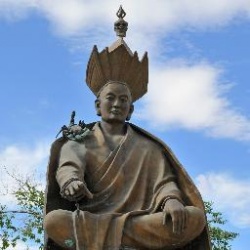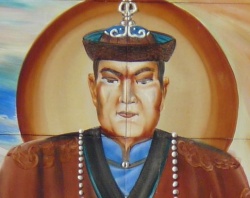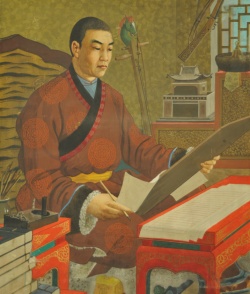Dulduityn Danzanravjaa
Dulduityn Danzanravjaa (1803–1856, Mongolian: Дулдуйтын Данзанравжаа) was a prominent Mongolian writer, composer, painter and physician and was the Fifth Noyon Khutagt, the Lama of the Gobi.
His name is a Mongolian adaptation of the last part of the Tibetan name Lobsang Tenzin Rabgye given to Danzan Ravjaa by the 4th Bogd Gegeen,
on his visit to the Mongolian capitol, Urga (present-day Ulaanbaatar) in 1812 where Danzanravjaa was also recognized as an Incarnate Lama (Tib: Tulku).
There are several versions concerning the origins and use of "Dulduityn". He was the 5th incarnation of the Gobi Noyon Hutagt, which is the title of a prominent line of tulkus of the Nyingmapa lineage of Tibetan Buddhism in Mongolia and was found by the personal attendant of the 4th Noyon Hutagt in 1809.
It was not possible to enthrone Danzan Ravjaa as the 5th Noyon Hutagt because of the ban from the ruling Manchu (Qing Dynasty on recognition of this line of incarnations.
Mongolia at the time was under Manchurian Qing control. He was enthroned as the Avshaa Gegeen in Ongiin Gol (present-day Saikhan-Ovoo) Monastery by Ishdonilhudev Rinpoche.
He is primarily famous for his poetry, but is also known for his prophecies, and treatises on medicine, philosophy, and astrology.
Life and work
Danzanravjaa was born in the Tüsheet Khan aimag's GobiMergen khoshuu, in what is today Khövsgöl sum of Dornogovi aimag.
His family was poor and his mother died while he was still young.
He and his father survived by begging and singing until 1809, when he was accepted as a disciple of Ishdoniilkhundev at Onggiyin Ghool Monastery, where was quickly acknowledged for his literary talent.
The monasteries he established at Galbyn Uul became religious centers and served as religious crossroads between Mongolia, China, and Tibet during his lifetime.
Other than his writings, he was also known for his syncretic combination of Yellow Hat(Gelug] and Red Hat sect(Nyingma,Sakya,Kagyu beliefs.
As a member of the Nyingma school of Tibetan Buddhism,Danzanravjaa was not required to refrain from alcohol or sexual intimacy, and he was well known for his love of both.
He frequently referred to the ecstasy he experienced with his lovers and took two wives. He also frequently referred to himself as a "boozer" (sokhtakhu) in his writing.
Danzanravjaa was unique in Mongolia for his times because he had a concern for public education.
At his Khamar Monastery he established a public library, museum, and primary school in addition to a professional public theater company called Saran Khukhuu.
The primary school was original for pre-revolutionary Mongolia since it had a secular curriculum focused on Mongolian and Tibetan literacy, mathematics, natural science, and history.
Graduates often went on to work in the theater company.
Danzanravjaa wrote in Mongolian and Tibetan, and created over 300 poems and more than hundred songs.
Among the most famous are the "Savior Mantra" and the song "Ulemjiin Chanar" praising the beauty of Mongolian women.
He also wrote the first Mongolian drama, Moon Cuckoo (Saran khökhöö).
A Joint Austrian-Mongolian expedition led by Michael Eisenriegler found Danzanravjaa's treasures hidden in the Gobi Desert. These artifacts are on display at the Danzan Ravjaa Museum in Sainshand.
Danzanravjaa died under mysterious circumstances. It is often claimed that he was murdered by poisoning, which is possible since he had many enemies during his lifetime.
He was unpopular with the Manchu rulers of the Qing Dynasty and the widow of a local ruler. However, there is no definitive evidence that his death was from murder, suicide, or simply illness.
Legacy
After Danzan's death one of his disciples, Sh. Balchinchoijoo (Ishlodon), collected his manuscripts and relics and served as their Curator (Takhilch), a role that passed down to his male heirs.
After the communist revolution the collection was buried for safekeeping in the mountains, and a map to the location continued to pass within the family of Curators.
The collection remained buried until the present Curator, Zundoi Altangerel, unearthed 24 boxes of manuscripts and relics in 1991 and transferred them to a small museum in Sainshand.
Another 22 boxes remained buried.
In 2009, Altangerel and Austrian archaeologist Michael Eisenriegler unearthed two more crates in an event that was simulcast on the Internet on TV.
In 2005 a digital archive of his original work was created with funding from the British Library's Endangered Archives Programme. It consists of 43,350 TIFF files. The project remains incomplete, however, since a number of the crates have been loaned out and not returned.
Bibliography and attributed works
- Perfect Qualities Poems of the 5th Noyon Khutagtu Danzanravjaa (1803–1856) Danzanravjaa (Author), Simon Wickham-Smith (Translator)(2006)
- Kohn, Michael Lama of the Gobi: How Mongolia's Mystic Monk Spread Tibetan Buddhism in the World's Harshest Desert, Blacksmith Books, (2010)
There are over 300 poems, 100 songs, numerous religious paintings, and a variety of treatises written in Tibetan and Mongolian by Danzanravjaa.
Notable works include:
- A ten volume operetta Saran Khukhuu (The Story of Moon Cuckoo), which satirized corrupt individuals in the society he lived in. It is also intended to be performed for a month by over 100 actors and 60 musicians.
- Ulemjiin Chanar, a song still sung today at celebrations.
- The poem Ichig Ichig (Shame, Shame), criticizes hypocrisy he perceived in society.
- The poem The Vigor of His White Body.
- Yertunts Avgain Jam (The Way of the World), a pessimistic poem purportedly written as he was dying.
Source
Wikipedia:Dulduityn Danzanravjaa


